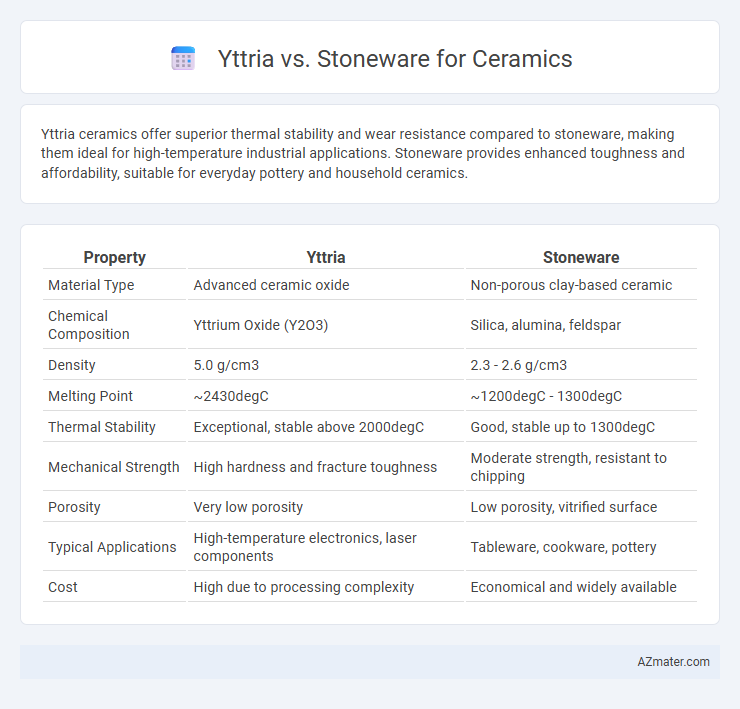Yttria ceramics offer superior thermal stability and wear resistance compared to stoneware, making them ideal for high-temperature industrial applications. Stoneware provides enhanced toughness and affordability, suitable for everyday pottery and household ceramics.
Table of Comparison
| Property | Yttria | Stoneware |
|---|---|---|
| Material Type | Advanced ceramic oxide | Non-porous clay-based ceramic |
| Chemical Composition | Yttrium Oxide (Y2O3) | Silica, alumina, feldspar |
| Density | 5.0 g/cm3 | 2.3 - 2.6 g/cm3 |
| Melting Point | ~2430degC | ~1200degC - 1300degC |
| Thermal Stability | Exceptional, stable above 2000degC | Good, stable up to 1300degC |
| Mechanical Strength | High hardness and fracture toughness | Moderate strength, resistant to chipping |
| Porosity | Very low porosity | Low porosity, vitrified surface |
| Typical Applications | High-temperature electronics, laser components | Tableware, cookware, pottery |
| Cost | High due to processing complexity | Economical and widely available |
Introduction to Yttria and Stoneware
Yttria (Yttrium Oxide) is a rare-earth oxide known for its high thermal stability, electrical insulation, and resistance to corrosion, making it ideal for advanced ceramic applications such as solid oxide fuel cells and high-temperature components. Stoneware, a durable ceramic made from clay fired at high temperatures between 1,100degC and 1,300degC, boasts excellent strength, water resistance, and versatility in everyday pottery and kitchenware. The fundamental difference lies in yttria's role as a specialized ceramic material with enhanced functional properties, while stoneware serves as a practical, traditional ceramic widely used for its toughness and aesthetic appeal.
Composition and Material Properties
Yttria, or yttrium oxide, is a rare earth compound known for its high thermal stability, excellent corrosion resistance, and ability to stabilize zirconia in ceramics, enhancing toughness and resistance to crack propagation. Stoneware, primarily composed of clay minerals with feldspar and quartz, is a dense, non-porous ceramic fired at high temperatures, offering strong mechanical strength and durability but lower thermal shock resistance compared to yttria-stabilized ceramics. The key difference lies in yttria's role as a stabilizer for advanced ceramic materials, providing superior high-temperature performance and fracture toughness, while stoneware's natural composition focuses on traditional durability and water resistance for everyday use.
Thermal Stability Comparison
Yttria ceramics exhibit superior thermal stability compared to stoneware, maintaining structural integrity at temperatures exceeding 2400degC, whereas stoneware typically withstands up to 1300degC. The high melting point and low thermal conductivity of yttria make it ideal for applications requiring resistance to thermal shock and prolonged exposure to extreme heat. Stoneware's porous microstructure results in lower thermal resistance, limiting its use in high-temperature industrial environments.
Mechanical Strength and Durability
Yttria-stabilized ceramics exhibit superior mechanical strength and enhanced durability compared to traditional stoneware due to their high fracture toughness and resistance to thermal shock. Stoneware, while durable and commonly used in everyday applications, generally shows lower mechanical strength and is more prone to chipping under stress. The incorporation of yttria improves the ceramic's structural integrity, making yttria-based materials ideal for high-performance and industrial ceramic applications.
Firing Temperatures and Processes
Yttria-enhanced ceramics require high firing temperatures around 1400degC to 1600degC to achieve optimal density and mechanical properties, making them ideal for advanced technical applications. Stoneware typically fires between 1200degC and 1300degC, producing durable, non-porous ceramics suited for everyday use and functional wares. The longer firing process and higher temperature of yttria ceramics contribute to superior thermal stability and strength compared to stoneware.
Surface Finish and Aesthetic Qualities
Yttria ceramics exhibit a smooth, glass-like surface finish with high translucency and uniform texture, making them ideal for applications where a refined aesthetic is crucial. Stoneware presents a more rustic and matte surface, characterized by natural variations and slight roughness that enhance its artisanal and earthy appeal. The choice between yttria and stoneware hinges on the desired visual effect, with yttria offering sleek modern elegance and stoneware providing traditional, textured warmth.
Chemical Resistance and Reactivity
Yttria ceramics exhibit exceptional chemical resistance due to their stable yttrium oxide composition, making them highly inert and suitable for harsh acidic or basic environments. Stoneware, composed mainly of clay and feldspar, offers moderate chemical resistance but can react with strong acids or alkalis over time, leading to surface degradation. The superior inertness of yttria ceramics ensures minimal reactivity, ideal for applications demanding long-term chemical stability.
Applications in Ceramics and Pottery
Yttria (yttrium oxide) is widely used in advanced ceramics for high-temperature applications due to its excellent thermal stability, mechanical strength, and resistance to corrosion, making it ideal for industrial components and electronic substrates. Stoneware, composed primarily of natural clays fired at high temperatures, is favored in traditional pottery and functional ware for its durability, water resistance, and aesthetic appeal. While yttria-based ceramics excel in technical and structural applications, stoneware remains the material of choice for artisanal pottery and everyday tableware due to its versatility and ease of shaping.
Cost and Accessibility
Yttria ceramics generally exhibit higher costs due to the expensive raw material and complex manufacturing processes, making them less accessible for large-scale or budget-conscious projects. Stoneware is more affordable and widely available, with abundant raw materials and simpler production methods that support mass manufacturing. Cost-efficiency and accessibility make stoneware the preferred choice for everyday ceramics, while yttria ceramics are reserved for high-performance or specialized applications requiring superior thermal and mechanical properties.
Choosing Between Yttria and Stoneware
Choosing between yttria and stoneware ceramics depends on the specific application requirements, as yttria offers superior thermal stability and high melting points ideal for advanced technological uses, while stoneware provides excellent durability and rustic aesthetics suitable for everyday functional pottery. Yttria ceramics are typically used in high-performance environments such as solid oxide fuel cells and thermal barrier coatings, whereas stoneware is preferred for its affordability, ease of firing, and resistance to chipping in household ceramics. Understanding the balance between yttria's high-temperature resilience and stoneware's practical toughness ensures the optimal selection for either industrial or artistic ceramic projects.

Infographic: Yttria vs Stoneware for Ceramics
 azmater.com
azmater.com